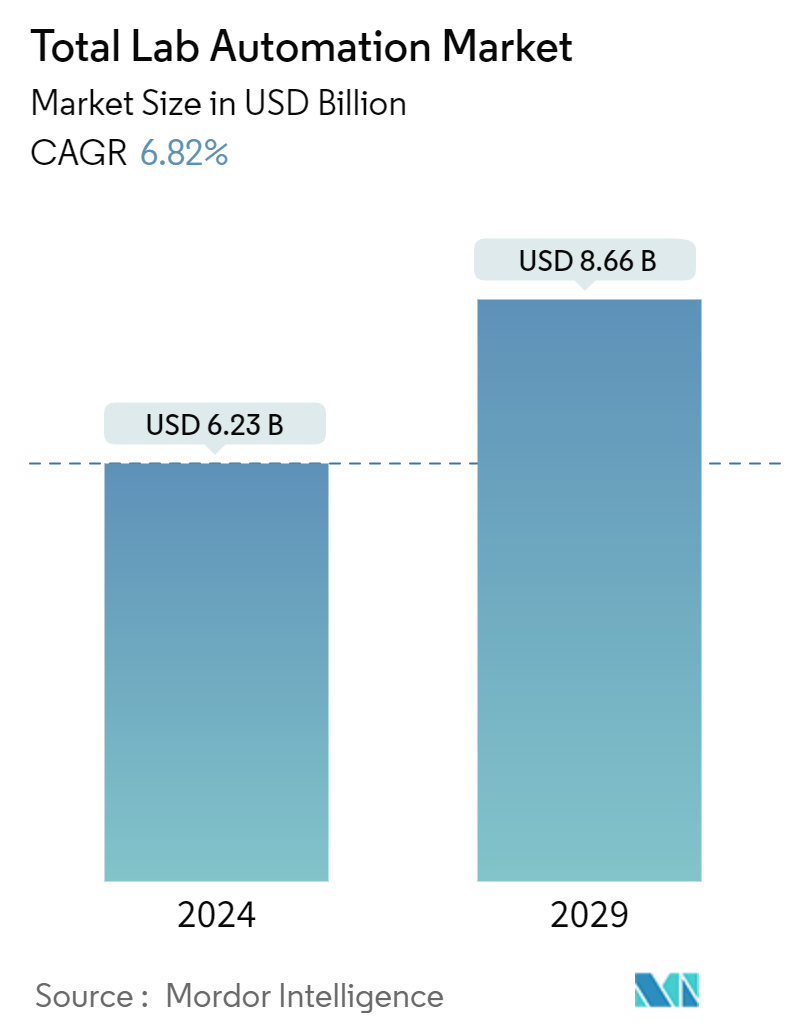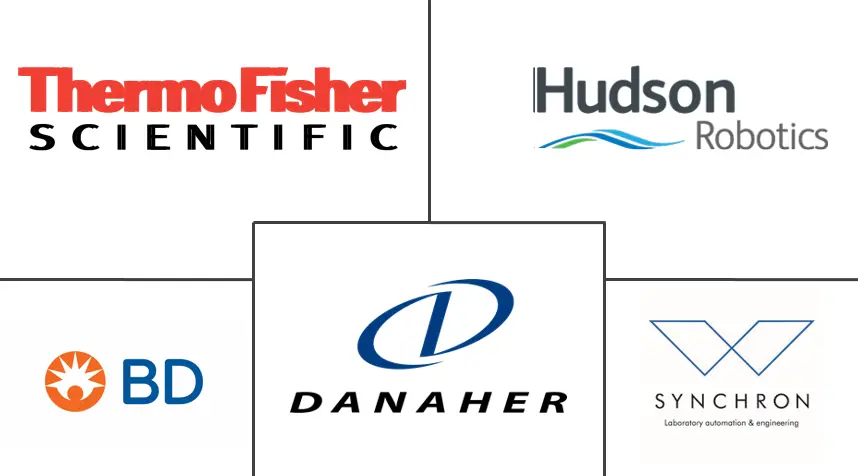Market Size of Total Lab Automation Industry

| Study Period | 2019 - 2029 |
| Market Size (2024) | USD 6.23 Billion |
| Market Size (2029) | USD 8.66 Billion |
| CAGR (2024 - 2029) | 6.82 % |
| Fastest Growing Market | Asia Pacific |
| Largest Market | North America |
Major Players
*Disclaimer: Major Players sorted in no particular order |
Laboratory Automation Systems Market Analysis
The Total Lab Automation Market size is estimated at USD 6.23 billion in 2024, and is expected to reach USD 8.66 billion by 2029, growing at a CAGR of 6.82% during the forecast period (2024-2029).
Technological advancements and increasing pressure to deliver results have led to the use of automated systems in laboratories, driving the market. The adoption rate of automated systems has been growing due to their accuracy, advanced data management capacity, reduced repetitiveness, and reduced human intervention.
- Laboratory automation contains computerized lab instruments and gadgets, which give many advantages, such as expanded profitability, enhanced work process scope, reduced time cycle, and improved information quality. Lab automation is vital to handle large volumes of sample tests in less time.
- For instance, automated liquid handlers are widely adopted in lab automation since they drastically reduce the time for processing and minimize the scope for sample contamination by dispensing dead volumes very efficiently. Liquid handlers work on software using an integrated system, which customizes handling procedures with large transfer volumes.
- With users expecting an immersive experience integrated with the Internet of Things (IoT), industries are now more dependent on automation than ever before. The Internet of Things (IoT) explosion enabled everything to be connected wirelessly, including heating, badging, lighting, sample collection and testing, and security cameras. Robots are restocking shelves in the medical sector; in hospitals, lifesaving medical equipment is connected, whereas manufacturing connects heavy machinery. These applications will drive the studied market in the future.
- Furthermore, in November 2021, Automata announced the launch of Automata Labs, an accessible, worry-free laboratory workflow automation solution to empower life science labs to innovate and upscale at pace. It transforms labs of all shapes and sizes by providing scientists with accessible, flexible, and end-to-end lab automation.
- Laboratories are facing pressure to produce faster turnaround times while also reducing errors to enhance patient care and therefore are using automation and robotics pervasive in clinical laboratories. The high-end automation in instruments and modular systems offers an array of highly user-friendly features. Most instruments can be integrated with IT to maximize the benefits of laboratory automation, which offers mechanized solutions in each workflow phase in a lab.
Laboratory Automation Systems Industry Segmentation
Total Laboratory Automation (TLA) is a laboratory automation system to carry out very repetitive activities. Robotic equipment is used in place of human operators to prepare and transport specimens.
The Total Lab Automation Market is segmented by Type of Equipment (automated liquid handlers, automated plate handlers, robotic arms, automated storage and retrieval systems (ASRS), and analyzers), by software (laboratory information management systems (LIMS), laboratory information system (LIS), chromatography data system (CDS), electronic lab notebook (ELN), and scientific data management system (SDMS)), by application (drug discovery, genomics, proteomics, clinical diagnostics, other applications), and by geography (North America, Europe, Asia-Pacific, and Rest of the World). The report offers market forecasts and size in value (USD) for all the above segments.
| By Type of Equipment | |
| Automated Liquid Handlers | |
| Automated Plate Handlers | |
| Robotic Arms | |
| Automated Storage and Retrieval Systems (ASRS) | |
| Analyzers |
| By Software | |
| Laboratory Information Management System (LIMS) | |
| Laboratory Information System (LIS) | |
| Chromatography Data System (CDS) | |
| Electronic Lab Notebook (ELN) | |
| Scientific Data Management System (SDMS) |
| By Application | |
| Drug Discovery | |
| Genomics | |
| Proteomics | |
| Clinical Diagnostics | |
| Other Applications |
| By Geography | |
| North America | |
| Europe | |
| Asia | |
| Australia and New Zealand | |
| Latin America | |
| Middle East and Africa |
Total Lab Automation Market Size Summary
The lab automation market is experiencing significant growth, driven by technological advancements and the increasing need for efficiency in laboratory processes. Automated systems are being adopted for their ability to enhance accuracy, manage data effectively, and reduce the need for human intervention, thereby improving productivity and workflow. The integration of the Internet of Things (IoT) has further propelled the market, enabling seamless connectivity and automation across various laboratory functions. This trend is particularly evident in the medical and pharmaceutical sectors, where automation is streamlining processes such as sample collection, testing, and drug discovery. Companies are investing heavily in automation solutions to optimize workflows, reduce errors, and accelerate research and development activities.
North America is poised to hold a significant share of the lab automation market, supported by substantial investments in clinical research and the presence of major pharmaceutical companies. The region's regulatory environment, with bodies like the Centers for Medicare & Medicaid Services overseeing laboratory testing, presents opportunities for automation providers. The market is moderately consolidated, with key players expanding their presence through strategic acquisitions and collaborations. Innovations such as automated liquid handlers and robotic systems are enhancing laboratory capabilities, while companies like Thermo Fisher Scientific and Becton Dickinson & Co. are leading the charge in providing advanced automation solutions. These developments are expected to drive the market's growth, as laboratories seek to improve efficiency and maintain competitiveness in an increasingly data-driven landscape.
Total Lab Automation Market Size - Table of Contents
-
1. MARKET INSIGHTS
-
1.1 Market Overview
-
1.2 Industry Attractiveness - Porter's Five Forces Analysis
-
1.2.1 Bargaining Power of Suppliers
-
1.2.2 Bargaining Power of Consumers
-
1.2.3 Threat of New Entrants
-
1.2.4 Threat of Substitute Products
-
1.2.5 Intensity of Competitive Rivalry
-
-
1.3 Impact of COVID-19 on the Industry
-
-
2. MARKET SEGMENTATION
-
2.1 By Type of Equipment
-
2.1.1 Automated Liquid Handlers
-
2.1.2 Automated Plate Handlers
-
2.1.3 Robotic Arms
-
2.1.4 Automated Storage and Retrieval Systems (ASRS)
-
2.1.5 Analyzers
-
-
2.2 By Software
-
2.2.1 Laboratory Information Management System (LIMS)
-
2.2.2 Laboratory Information System (LIS)
-
2.2.3 Chromatography Data System (CDS)
-
2.2.4 Electronic Lab Notebook (ELN)
-
2.2.5 Scientific Data Management System (SDMS)
-
-
2.3 By Application
-
2.3.1 Drug Discovery
-
2.3.2 Genomics
-
2.3.3 Proteomics
-
2.3.4 Clinical Diagnostics
-
2.3.5 Other Applications
-
-
2.4 By Geography
-
2.4.1 North America
-
2.4.2 Europe
-
2.4.3 Asia
-
2.4.4 Australia and New Zealand
-
2.4.5 Latin America
-
2.4.6 Middle East and Africa
-
-
Total Lab Automation Market Size FAQs
How big is the Total Lab Automation Market?
The Total Lab Automation Market size is expected to reach USD 6.23 billion in 2024 and grow at a CAGR of 6.82% to reach USD 8.66 billion by 2029.
What is the current Total Lab Automation Market size?
In 2024, the Total Lab Automation Market size is expected to reach USD 6.23 billion.

